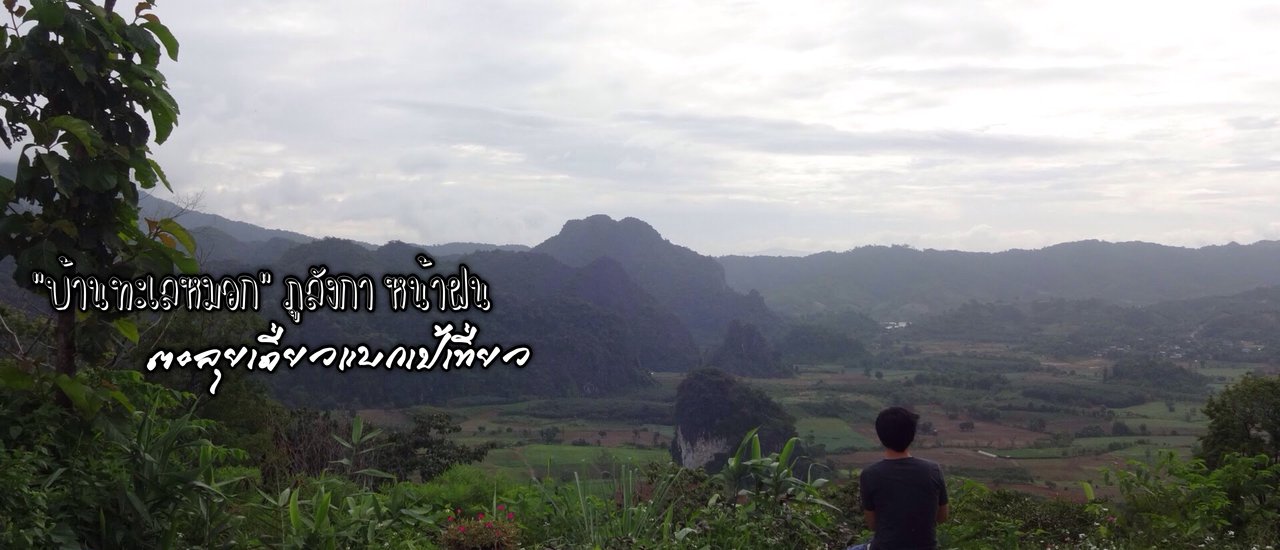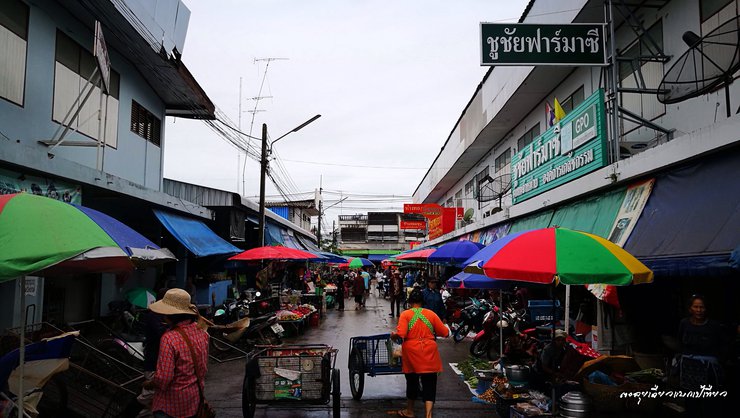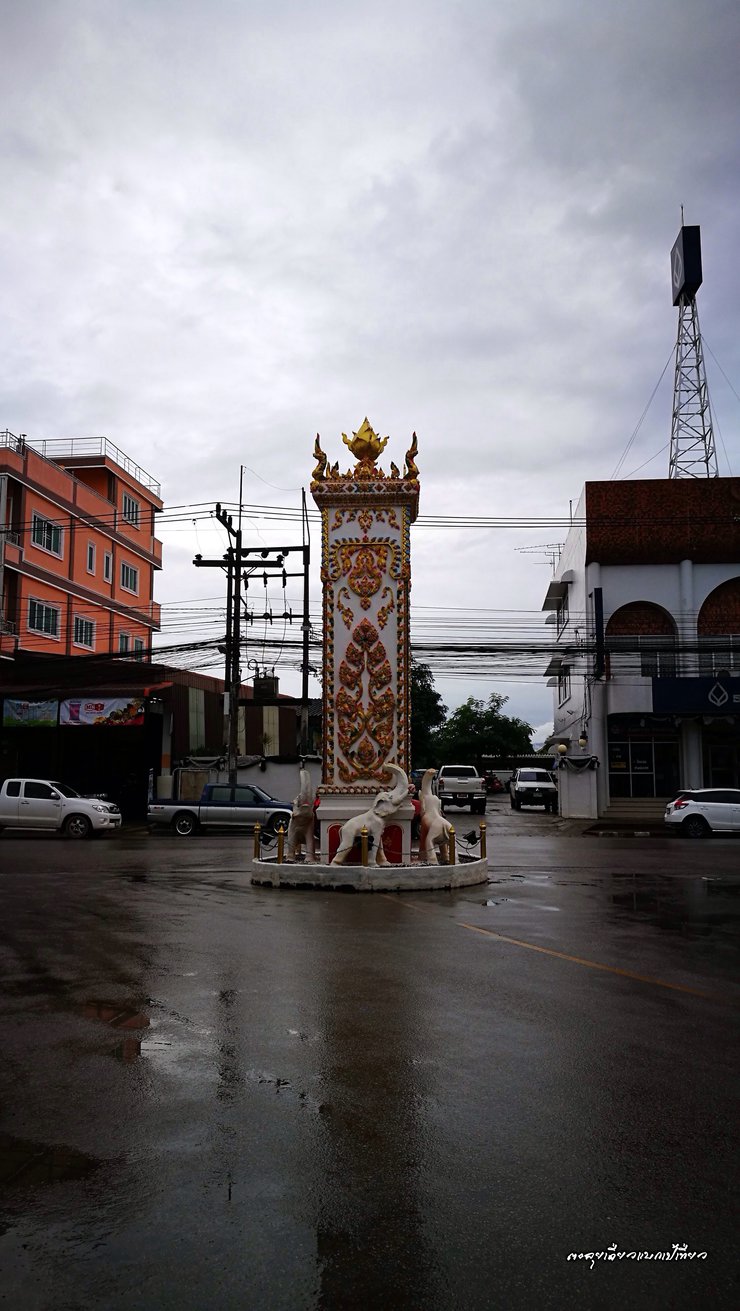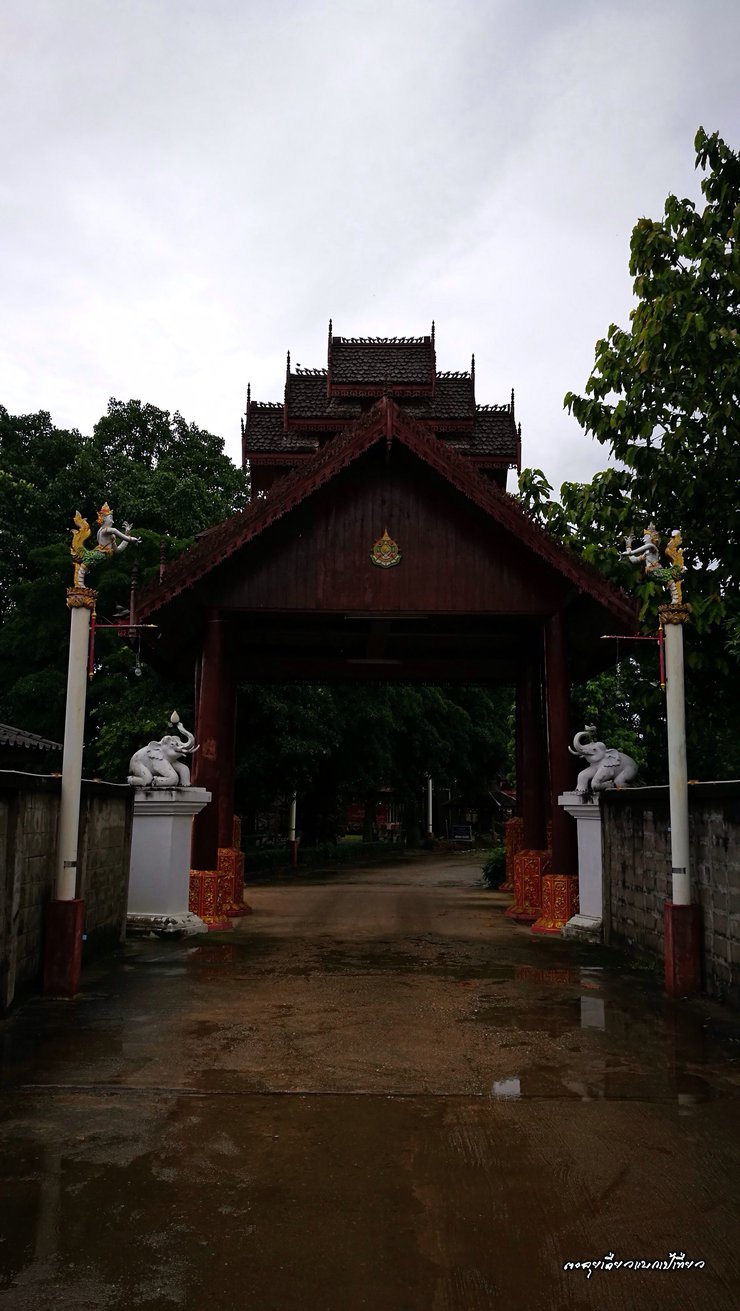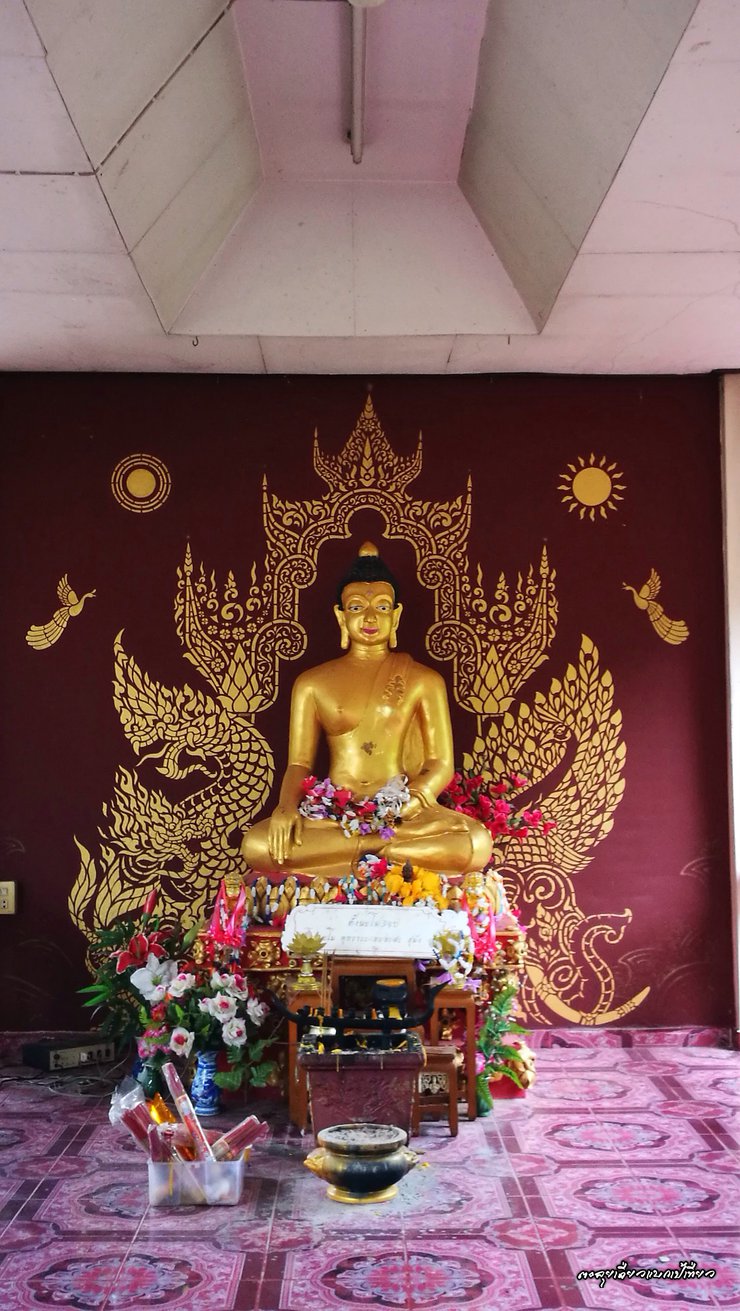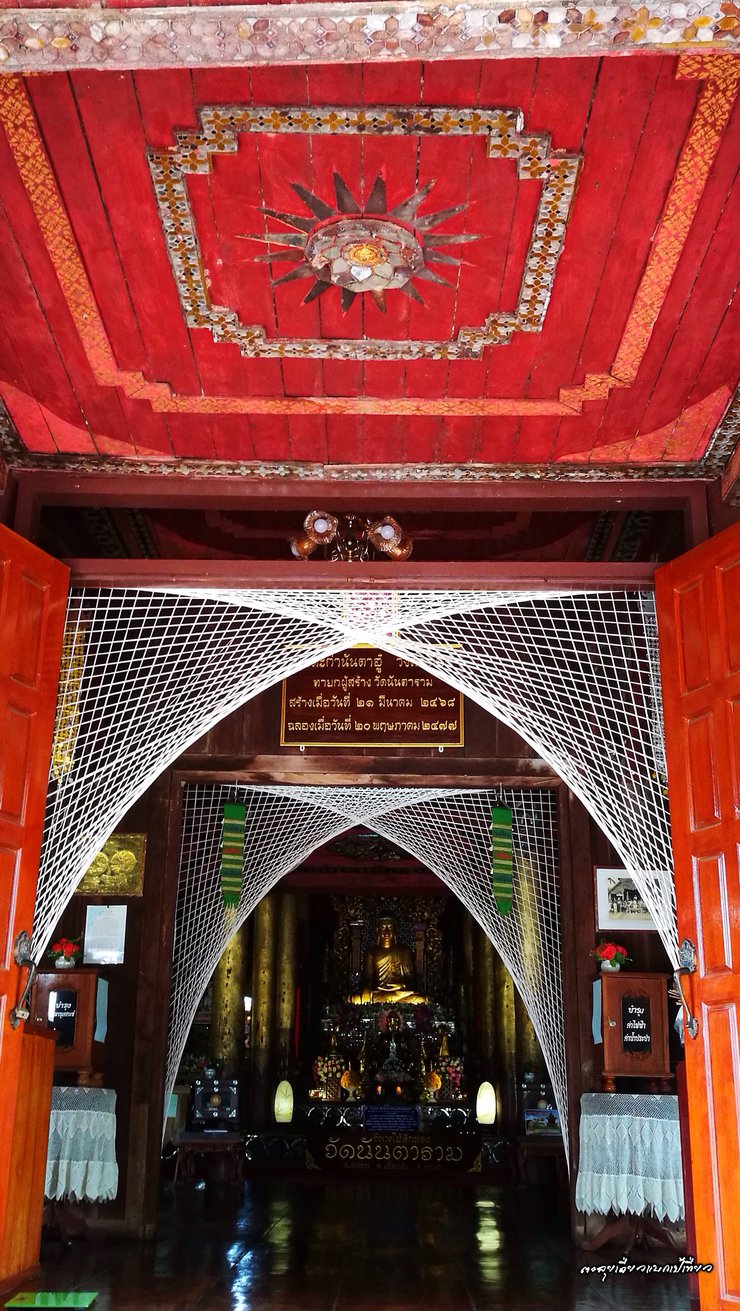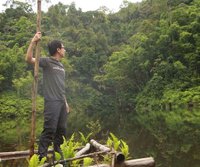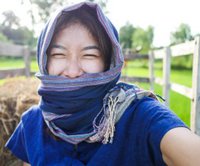This trip was a spontaneous decision. We just wanted to visit Phu Langka again and try a different accommodation. We found Baan Talay Mok and booked our stay for June 15-16, 2017.
Getting to Baan Talay Mok
- By bus: The most convenient option is to take a bus to Chiang Kham and then wait for the Chiang Rai-Nan bus, which departs once a day at 12:00 PM. Inform the driver that you want to get off at Baan Talay Mok.
- By bus to Chiang Rai or Nan: Take the same bus as in option 1, but the bus departs at 9:00 AM. When buying your ticket, tell the staff that you want to get off at Pang Ma O. Once on the bus, inform the driver and conductor that you want to get off at Baan Talay Mok.
- By plane: Fly to Chiang Rai, which is closer. From the airport, take a taxi to the old bus station and then follow option 1.
- By private car: You can hire a car from Chiang Kham bus station. There are two-wheeled vehicles available. Negotiate the price directly with the driver, as we don't know the cost.
We opted for a bus journey, utilizing the Somboon Tour service departing at 8:00 PM and arriving in Chiang Kham. The journey was straightforward, and we arrived at 6:30 AM amidst a light drizzle. We ventured out to explore the morning market, braving the rain. The vibrant colors of umbrellas added a splash of vibrancy to the rainy day. The market offered a diverse selection of goods, including fresh produce, dried goods, clothing, and more.

Continue walking past the market and you will find a small clock tower.

Continuing on the left, I saw a sign indicating the way to Wat Nantaram, 330 meters away. The distance was comfortable, so I decided to take a look while waiting for the rain to stop. Along the way, I had the opportunity to chat with a local resident, who informed me that the temple was beautiful. As I continued walking, I eventually came across the temple's entrance archway.

Entering from the right-hand side, you will see a pavilion housing the Phra Chao Tan Jai, a gilded stucco Buddha statue in the Singh style. The statue was completed within one day.

The exact date of construction is unknown. In 1925, Nantha (U) Wong-anan, a Pa-O elder, renovated the temple and designed and built the entire wooden viharn in the style of Lower Burma.
The temple is located 330 meters from the market, within walking distance. We carried our backpacks and walked there. We went in the morning when there were no people taking pictures, which was comfortable. We also had the opportunity to listen to the history of the temple from the abbot. He took us to see the temple, the museum, and exchanged ideas on how to attract people to the temple through tourism. There will be a "Poi Sang Long" festival here, similar to Mae Hong Son. They just started reviving this tradition last year. Thanks to the local volunteer guide who gave us a lot of advice and suggested good angles for taking pictures.
The golden teakwood vihara houses a Buddha statue adorned with fragrant flowers. The flowers, sourced from various species in Taunggyi, Myanmar, are dried, ground, and mixed with lacquer, burnt straw ash, and termite mound soil or brick and mortar to create the statue, which is then gilded.
The sentence is already in English and does not require translation.




The back of the temple houses a museum that displays historical artifacts donated by villagers and collected by the abbot, including items related to the Pa'O ethnic group.



Exiting the golden teakwood viharn, on the right-hand side, you will find the ubosot (ordination hall) and the 25th-century stupa, standing tall at 23.84 meters.

Continuing to the bell tower to capture a distant view, capturing the entire golden teakwood temple. This angle was recommended by the volunteer guide, an elderly gentleman.

After leaving the temple, I walked back to the market to find something to eat. I walked around the market but only found fresh produce. I then walked towards Ban Yuan School, which has a beautiful wooden building.

Crossing the bridge, you will find a health park and a shop selling "khanom jeen" (rice noodles) owned by an aunt. However, we opted for a spicy and flavorful chicken khao soi, which cost 40 baht.

After a hearty meal at Baan Talay Mok, we received a call from our guide. We met him at the Chiang Kham District Office, where he suggested exploring Chiang Kham before heading to Phu Langka. Our first stop was the Heen Tai Lue Mae Saeng Da, a well-preserved ancient house and the last remaining Heen Tai Lue dwelling still inhabited.







Before leaving home, the grandmother bought four Tai Lue-style woven keychains and a bottle of sesame oil. She actually wanted a hand-woven shirt, but the price was a bit high. Leaving the Tai Lue village of Mae Saeng, we continued to Wat Yuan, an ancient temple in Chiang Kham district. Wat Yuan was built in 1687 and received the royal ordination in 1908. It belongs to the Mahanikai sect and is the spiritual center of the Tai Lue people of Ban Yuan.


After leaving Wat Yuan, we arrived at Wat Saen Mueang Ma, which is less than 100 meters from Chiang Kham Bus Station. Wat Saen Mueang Ma was built during the reign of King Rama I around 1798 by the people of Mueang Ma, Yunnan Province, who were rounded up by the ruler of Nan and settled in Chiang Kham District. The highlight of the temple is the multi-layered roof of the viharn, which is not typically high. The roof is adorned with chofa finials in the shape of carved swans or nagas holding jewels. It is also decorated with carved wood and painted in various colors, creating a beautiful sight. The doors are all made of carved wood. The entrance to the viharn has three porches, each with three animals believed to protect and preserve religion: the naga, the tiger, and the lion. The walls inside are decorated with murals depicting the Tai Lue way of life. The main Buddha image is a Chiang Saen period Buddha statue.
The original text is empty. Please provide the text you want me to translate.


The Tai Lue people bought the city of Ngai inside the Tai Lue Local Museum at Wat Saeng Muang Ma.

Note: The original text is empty, so the translation is also empty.



After leaving the temple, we stopped by the Thang Fah Khao Soi restaurant and had 3 bowls of delicious and affordable Khao Soi for only 75 baht.

After a satisfying meal, we continued our journey to Wat Phra Nang Din. Inside the main hall, the revered Phra Nang Din Buddha statue resides (encased within a glass frame). Legend has it that villagers attempted to construct a pedestal to elevate the statue, but despite their best efforts, it remained immovable, earning it the name "Phra Nang Din," which translates to "the seated Buddha." According to legend, this statue dates back to the time of the Buddha himself, making it approximately 2,500 years old. Its construction took a remarkable 1 month and 7 days. Notably, unlike most Buddha statues, Phra Nang Din sits directly on the ground without a pedestal.


After leaving Wat Phra Nang Din, we continued to Wat Chiang Ban.
The sentence is already in English and does not require translation.


After leaving the temple, we stopped for coffee and cake at the shop in front of Chiang Ban Resort. It was quite good.


After lunch, my brother stopped by the Pong District Office to run some errands. He then took us to Siam Pony, which is currently closed to the public due to the rainy season.


After leaving Siam Pony, we arrived at the Monument of Selfless Sacrifice.

And then it was time to travel up to Phu Langka, Pong District. Along the way, a rainbow came out to welcome us.

We soon reached the path leading to the top of Phu Langka. A short distance further, we stopped to admire a vegetable plot covered with netting. This plot is used to grow sweet peppers for the Royal Project.

We have arrived at the Sea of Mist House. We are taking a walk and taking pictures before exploring the area.



Please check the bathroom before using it. It is a shared bathroom with both squat and sit-down toilets. There is a water heater available.



We were the only guests tonight. The owner told us to choose any room we wanted, so we chose the three-bedroom room. The beds were on the floor, but they had all the necessary bedding and fans (although the weather was cool, so we didn't need them). This room normally sleeps six people.

In the evening, we sat outside at the bar, enjoying the soft lighting and relaxing music. We chatted about our travels, the local way of life, and the diverse range of tourists we encountered.


The next morning, I woke up a little late and didn't see the sun or any fog. However, the atmosphere was incredibly peaceful, and I was able to capture stunning photos of Khao Chang Noi without any crowds. It was truly a serene experience.




Grabbing a basket to go out and have fun with the dog, but not going far.

She brought over a coffee dripper for us to enjoy before our meal.
We opted for a medium roast, offering a balanced aroma and intensity.

Simple but delicious breakfast

After we were full, my brother took me down to Khao Chang Noi. I wanted to go down last time, but I didn't have the chance. This time, my wish came true.


The journey then took us across provinces to Nan, where we visited the Pha Thar waterfall within Tham Sa Kaen National Park. Upon reaching the parking area, there were designated spots for enjoying the waterfall.


The next step is to climb about 400 meters through lush greenery. The path is not difficult and offers a refreshing experience.

After descending from the waterfall, I encountered an unusual banana tree with a peculiar flower bud before reaching my vehicle.

On the way back, you will see a mountain that resembles a Chinese monk raising his hand in greeting.

Before returning to collect our belongings, my brother, his friends, and I had lunch with the children at Ban Sa Kae School. We also made a donation.


After returning to the accommodation to shower and pack, my brother picked me up and drove me to Chiang Kham. Before leaving, we stopped by Pha Daeng Coffee Shop for a cup of coffee. The shop uses peaberry beans, which are fragrant and delicious.


Exiting the shop, we encountered the Chiang Rai car. Our driver, Phi, had arranged for us to follow it to avoid a long wait. We caught up with it at the second red light and boarded the car in the middle of the road.
Impressions
- Chiang Kham is beautifully serene and has a lot of charm.
- The food is delicious, and the coffee is good too.
- The accommodation is excellent, with comfortable beds, a safe environment, and great hospitality from N' Nat. For booking inquiries, you can contact Baan Talay Meuk through this link: http://www.facebook.com/natthapong.tee.
Follow other travel trips at
Page: Solo backpacking travel
IG: prapat / Solo backpacking travel

ตะลุยเดี่ยวแบกเป้เที่ยว
Wednesday, October 9, 2024 5:57 PM

